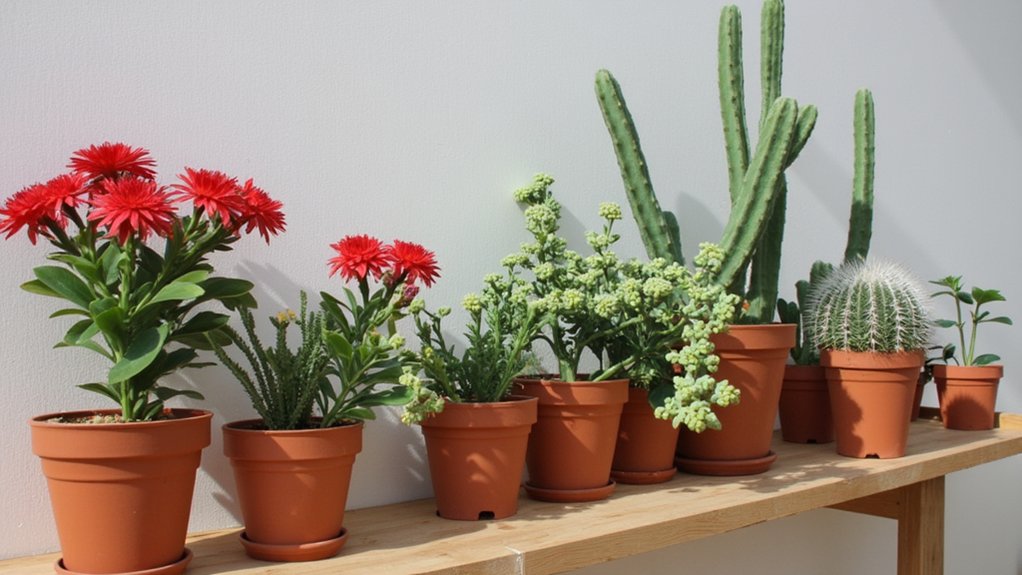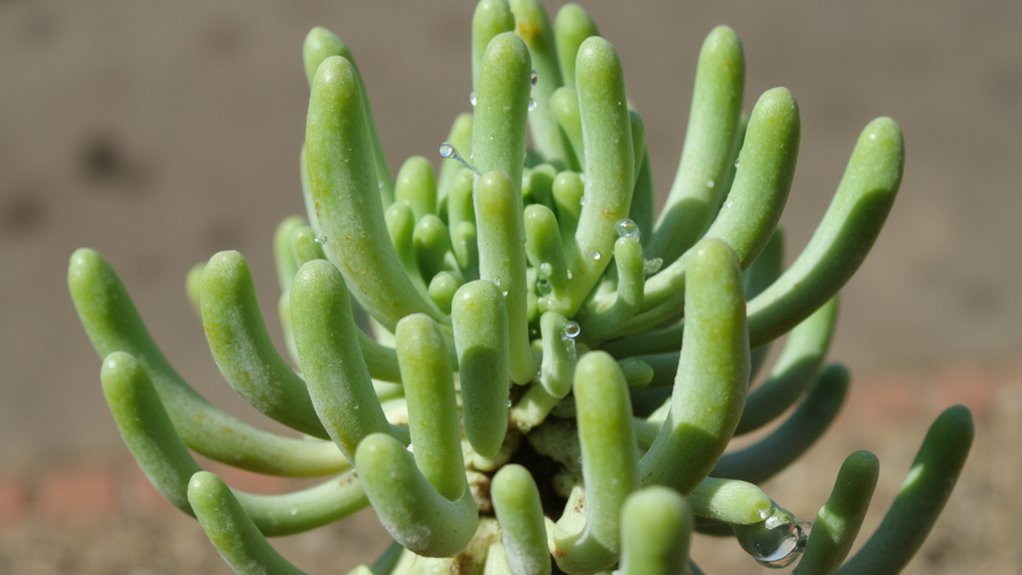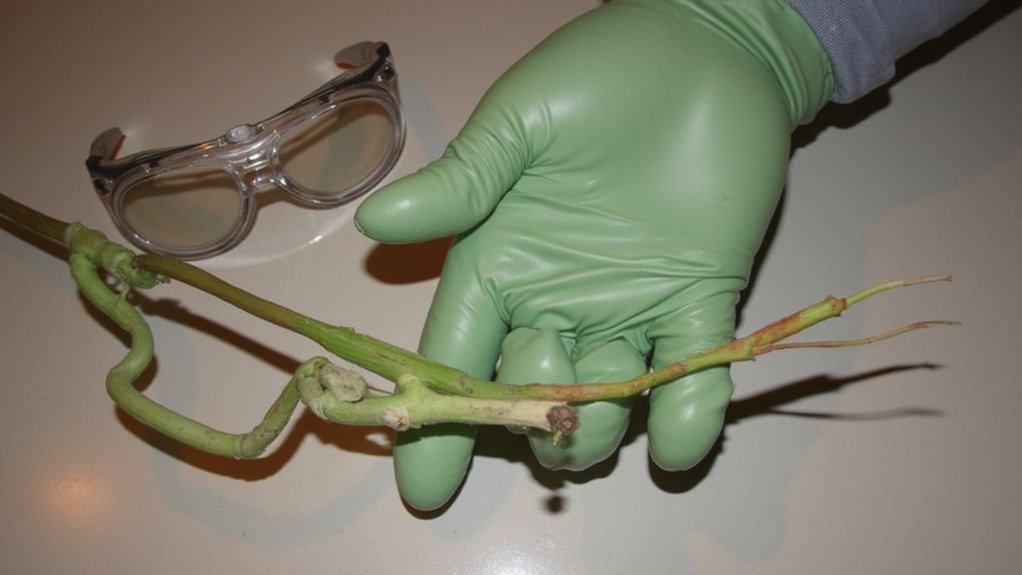When you spot a Crown of Thorns Euphorbia blooming in winter while other houseplants rest, you’ll understand why these adaptable succulents make such intriguing indoor specimens. You’ll need to master a few essential techniques to keep your Euphorbia thriving, especially since their toxic sap demands careful handling. Whether you’re drawn to their architectural stems or unusual flowers, success with these plants hinges on understanding their distinct care requirements.
Contents
- 1 Types of Indoor Euphorbia Plants
- 2 Light and Temperature Requirements
- 3 Watering and Humidity Needs
- 4 Soil and Potting Considerations
- 5 Safe Handling and Toxicity Precautions
- 6 Fertilizing Your Euphorbia
- 7 Pruning and Maintenance Tips
- 8 Common Pests and Diseases
- 9 Propagation Methods
- 10 Seasonal Care Guide
Types of Indoor Euphorbia Plants

While there are over 2,000 species in the Euphorbia family, only certain varieties thrive as houseplants. You’ll most commonly find Crown of Thorns (Euphorbia milii), African Milk Tree (Euphorbia trigona), and Pencil Cactus (Euphorbia tirucalli) available for indoor growing.
For subtle indoor charm, consider the small but striking Myrtle Spurge (Euphorbia myrsinites) or the coral-like branches of the Indian Tree Spurge (Euphorbia tirucalli ‘Sticks on Fire’). If you’re looking for statement plants, you can’t go wrong with the dramatic Candelilla (Euphorbia antisyphilitica) or the sculptural Madagascar Jewel (Euphorbia leuconeura), both reaching heights of 4-6 feet.
Light and Temperature Requirements
Although Euphorbias can adapt to various conditions, most varieties thrive in bright, indirect sunlight for 4-6 hours daily. You’ll want to place them near east or west-facing windows, where they’ll receive gentle morning or late afternoon rays without intense mid-day exposure.
These succulents prefer temperatures between 65-75°F (18-24°C) during the day and can handle nighttime drops to 50°F (10°C). Keep them away from cold drafts near windows or air conditioning vents. If you’re growing them outdoors during summer, bring them in when temperatures dip below 50°F to prevent cold damage and leaf drop.
Watering and Humidity Needs

Proper watering habits make a significant difference in your Euphorbia’s health, just as much as the right light exposure. Water your plant only when the top 2 inches of soil feel completely dry, typically every 10-14 days during growing season and less frequently in winter.
These succulents don’t need high humidity, preferring levels between 30-50%. If you’re growing them in a bathroom or naturally humid space, guarantee good air circulation to prevent fungal issues. Never mist the foliage directly, as water droplets can cause spotting and encourage rot.
When watering, pour water at the base until it drains freely, then empty the catchment tray immediately.
Soil and Potting Considerations
Since Euphorbias can’t tolerate wet feet, you’ll need a fast-draining potting mix that mimics their natural desert habitat. Create a blend using two parts regular potting soil, one part coarse sand, and one part perlite or pumice to guarantee excellent drainage.
Choose a pot with drainage holes that’s just 1-2 inches wider than your plant’s root ball. Terra cotta containers work best as they allow moisture to evaporate through their porous walls. When repotting, wait one week before watering to allow any damaged roots to heal, and always wear gloves to protect yourself from the plant’s irritating sap.
Safe Handling and Toxicity Precautions

When handling Euphorbia plants, you’ll need protective gear due to their highly toxic white sap, which can cause severe skin irritation and burns. Always wear thick rubber gloves, long sleeves, and protective eyewear before pruning or repotting.
If you get sap on your skin, immediately wash the area with soap and water for at least 15 minutes. Keep these plants away from children and pets, as ingestion can cause intense stomach pain and vomiting. Place warning labels on your Euphorbia pots as a reminder.
Store pruning tools separately and clean them thoroughly with rubbing alcohol after each use to prevent sap contamination.
Fertilizing Your Euphorbia
Your indoor Euphorbia needs light fertilization to thrive during its active growing season, which typically runs from early spring through late summer. Apply a balanced, water-soluble fertilizer (10-10-10) diluted to half-strength once every 4-6 weeks.
Don’t fertilize during fall and winter when the plant’s growth naturally slows down. If you notice yellowing leaves or stunted growth, you might need to increase feeding frequency to every 3 weeks. However, it’s better to under-fertilize than over-fertilize, as these succulents can be sensitive to excess nutrients. Always water thoroughly before applying fertilizer to prevent root burn.
Pruning and Maintenance Tips
Regular maintenance, like proper fertilizing, helps keep Euphorbias healthy – but pruning takes that care to the next level. Use clean, sharp pruning shears to remove dead, damaged, or crossing branches whenever you spot them. Always cut at a 45-degree angle, making cuts 1/4 inch above a leaf node.
When handling your Euphorbia, don’t forget to wear thick gloves and protective eyewear, as the plant’s milky sap can cause skin irritation. If you’re shaping the plant, trim no more than 1/3 of the total growth at once, and always prune in early spring before new growth begins.
After pruning, clean your tools with rubbing alcohol to prevent disease spread.
Common Pests and Diseases
Although Euphorbias are generally hardy plants, they remain vulnerable to several common indoor pests and diseases. Mealybugs, spider mites, and scale insects often target these succulents, clustering around leaf joints and stems. You’ll need to check your plant weekly for these invaders.
Root rot poses the biggest disease threat, typically caused by overwatering or poor drainage. If you notice yellowing leaves or a soft, mushy stem base, you’ve likely got root rot. Powdery mildew can also appear as white patches on leaves, especially in humid conditions with poor air circulation.
To treat pests, use rubbing alcohol on a cotton swab, or apply neem oil spray every 7-10 days.
Propagation Methods
Three proven methods exist for propagating Euphorbia plants: stem cuttings, seeds, and division. For stem cuttings, you’ll need to wear gloves and cut 4-6 inch sections at a 45-degree angle, then let them callus for 24 hours before planting in well-draining soil.
Seeds should be sown in spring, scattered on the surface of moist soil, and kept at 70°F until germination occurs in 14-21 days. Don’t cover them, as they need light to sprout.
Division works best with mature, clumping varieties. Simply dig up the plant, separate the roots into sections with at least one growing point, and replant immediately.
Seasonal Care Guide
Since Euphorbia plants adapt their growth patterns to seasonal changes, you’ll need to adjust your care routine throughout the year. During spring and summer, water your plant every 7-10 days and feed it monthly with a balanced 10-10-10 fertilizer.
In fall, reduce watering to every 14 days and stop fertilizing completely. When winter arrives, only water when the soil is completely dry, typically every 3-4 weeks. Maintain temperatures between 60-75°F year-round, but keep your Euphorbia away from cold drafts from windows or air vents.
Move your plant 2-3 feet back from south-facing windows during intense summer months to prevent leaf scorch.
